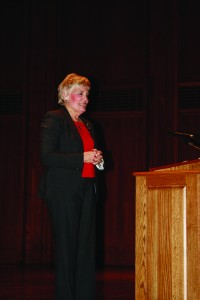By Eric Soble
Opinions Editor
Americans spend 450 billion dollars a year on Christmas. This is a great statistic: it shows that we give valuable gifts to our friends and families, that we demonstrate our love and dedication and that we care about our fellow human beings. However, this becomes detestable once we consider our current international situation.
Every 20 seconds, a child dies from a water-borne disease—more than AIDS and malaria combined. What is the cost of providing sanitary, clean water to all the world’s citizens? According to the United Nations Development Program, 10 billion dollars per year would be more than enough.
Yet our priorities lie in buying ugly sweaters that the recipient will never wear and investing in gift certificates when we have no other ideas. Given our globalized world and the advent of the Internet, this crisis can no longer be attributed to ignorance. It is an informed and calculated form of neglect and avoidance.
I have all the typical gripes about unnecessary consumerism, decorative competitions and crazed mothers stampeding over others to procure limited edition toys. But I like the holidays. They’re sentimental and heartwarming—and this comes from a person who cannot be called religious be any stretch of the imagination.
This makes the mean-hearted and pompous remarks made by those who claim to be the exclusive guardians of Christmas even more unbearable around this time of year. The War on Christmas is of particular academic interest to me, namely because it is a telling social commentary on cultural dissonance. But there is also entertainment value in the inherent hypocrisy and lunacy involved. Seriously, I spend time over the holidays eating cookies and watching Fox News. It never fails to bring out gems like this, from Bill O’Reilly:
“See, it’s all part of the secular progressive agenda, to get Christianity and spirituality and Judaism out of the public square. Because if you look at what happened in Western Europe and Canada, if you can get religion out, then you can pass secular progressive programs like legalization of narcotics, euthanasia, abortion at will.”
The conservative organization, American Family Association, is now putting out a “Naughty or Nice Christmas List,” which exhorts buyers not to shop at stores that wish you “Happy Holidays.” The organization has boycotted many stores including Sears, Target and Wal-Mart for not specifically mentioning Christmas on their websites or playing Christian music in their stores.
Every year, there are also tremendous legal fights surrounding the public display of religious symbols. Many court cases, like ACLU v. Allegheny and Lynch v. Donnelly, have struggled with the demarcation between the secular and the religious.
Ultimately, this war on Christmas is a war on information. It has spawned because phrases have been repeated ad nauseum and taken to be true. Here are several misconceptions I wish to clear up before the war on Christmas begins this year:
- No one is trying to take away Christmas from any individual believer. The legal battles over Christmas simply ensure that we have, as Kant would say, a “disinterested public sphere” wherein one religion is not given preference over another. Please remember this paradox: the only guarantee of religious liberty is secularism.
- Children are still allowed to pray in school. It is part of their free speech. Engel v. Vitale states that the only prayer not allowed in schools is institutional prayer. This occurs when a teacher requires the prayer or subjects students to prayer as a “captive audience.”
- This time of year is not exclusively for Christians, and never was. It is, of course, your right to pressure stores into playing obnoxious pop remixes of hymns, but it is not your right to insist that everyone must conform to your conception of the winter solstice. It is for everyone: Jews, Hindus, Muslims and nonbelievers.
- When Christmas is not imposed in schools or flaunted on public property, you are not being victimized. You may still believe whatever you wish to believe on your own time and without the aid of taxpayers’ dollars. But to insist that 78 percent of the nation is “oppressed” because they can’t implement their own beliefs on others is total foolishness.
But then again, this War on Christmas has never been about restoring the true meaning of Christmas. It has and will continue to be about rallying against something, even if that something is as benign as “Happy Holidays.” If people are willing to fight for something around this time of the year, shouldn’t it be something worthwhile? Let’s get working on those water filtration systems. Let’s give money to the rebuilding in New Orleans. It isn’t what holiday you’re celebrating, if any at all: it’s what you do with it.

